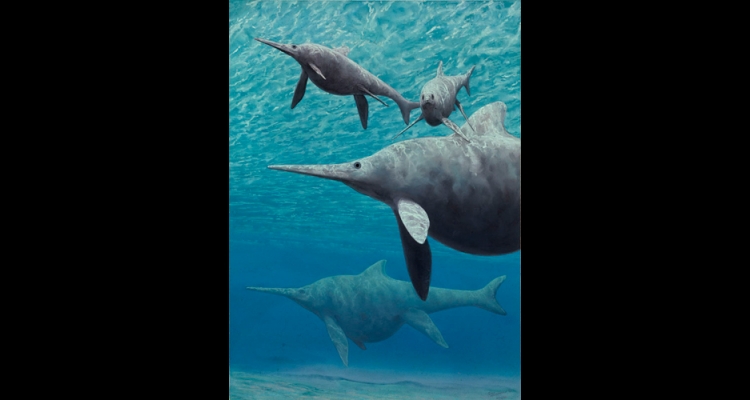Ichthyosaurs
Berlin-Ichthyosaur State Park is located near the center of Nevada, among the pinyon pines and junipers of the Shoshone Mountains, off a path already off the beaten path. This odd, remote park pairs the ghost town of Berlin, a silver and gold mining center in the late nineteenth century and early twentieth century, with far older relicts: 225-million-year-old fossils of marine reptiles called ichthyosaurs. Many of these animals died in this area and were preserved in sediments of the ocean (the forerunner of the Pacific) that at the time extended east to Central Nevada. The fossilized ichthyosaurs were discovered by miners in Berlin, who decorated their homes with ichthyosaur bones and used the large vertebrae as dinner plates, but it was not until the 1950s and 1960s that paleontologists excavated the site. Berlin’s ichthyosaur species was named Shonisaurus popularis, after the Shoshone Mountains, and it proved to be such a spectacular find that it was designated the official state fossil of Nevada in 1977.
Ichthyosaurs first appeared in the early Triassic Period, about 250 million years ago, and disappeared some 160 million years later in the Cretaceous Period. They were fast-swimming predators with long snouts and streamlined bodies, leading to frequent comparisons with modern dolphins. Like dolphins, they bore live young – there are fossils of ichthyosaurs in the act of giving birth – and, thus, they did not have to come ashore to reproduce. However, ichthyosaurs had much smaller brains and much bigger eyes than dolphins, suggesting that they were not simply ancient analogues of those marine mammals.
The main fossil display at Berlin-Ichthyosaur State Park is an exposed bed of rock containing several ichthyosaur specimens. It takes a bit of imagination to assemble an image of graceful aquatic creatures from the jumble of bones. However, once one recognizes flippers, skulls, and backbones, the display makes a strong impression: these were very large animals. The skulls alone are five or six feet long, and the larger specimens look to be about 40 feet long. In fact, some ichthyosaurs found at the park were over 50 feet long, making Shonisaurus popularis the second largest ichthyosaur known. (The largest is a similar species from British Columbia.) Thus, although the ichthyosaurs of Berlin might have looked somewhat like deep-bodied dolphins, they were about the size of gray whales. The number of ichthyosaurs found at this site also is extraordinary; about 40 individuals have been uncovered, one of the largest concentrations of ichthyosaur fossils in the world.
Mysteries surround Shonisaurus popularis and ichthyosaurs in general. At least nine individuals (including those in the main display) apparently died close together and at the same time. Their proximity to each other suggests they formed a school or some other kind of aggregation, but why did they all die at once? One theory is that they beached themselves, like pods of whales sometimes do today. However, recent studies indicate that Berlin’s ichthyosaurs were deposited in deep water, not on the coast. A recent suggestion is that they succumbed to a severe and quick-acting form of food poisoning.
An odd characteristic of Shonisaurus popularis is that juveniles had teeth, but adults apparently did not. How did the adults catch prey without any teeth? It may be that they filtered small animals out of the water, like baleen whales do; however, there is no evidence of filtering structures in Shonisaurus or any other ichthyosaur. Another possibility is that they used suction feeding, expanding the throat so that water and prey were sucked into the mouth, a method that some modern whales use.
The biggest unanswered question concerning all ichthyosaurs is the kind of land reptile that gave rise to them. Paleontologists have considered many different groups as possible ancestors or close relatives of ichthyosaurs, but nothing close to a consensus has been reached. Part of the problem is that even the earliest known ichthyosaurs were so highly modified for an aquatic life that few traits strongly link them to any particular terrestrial reptile group. Solving the mystery of ichthyosaur origins may have to await the discovery of a fossil “missing link” that retains more of the features of its terrestrial relatives.
Article Locations
Related Articles
Further Reading
None at this time.



